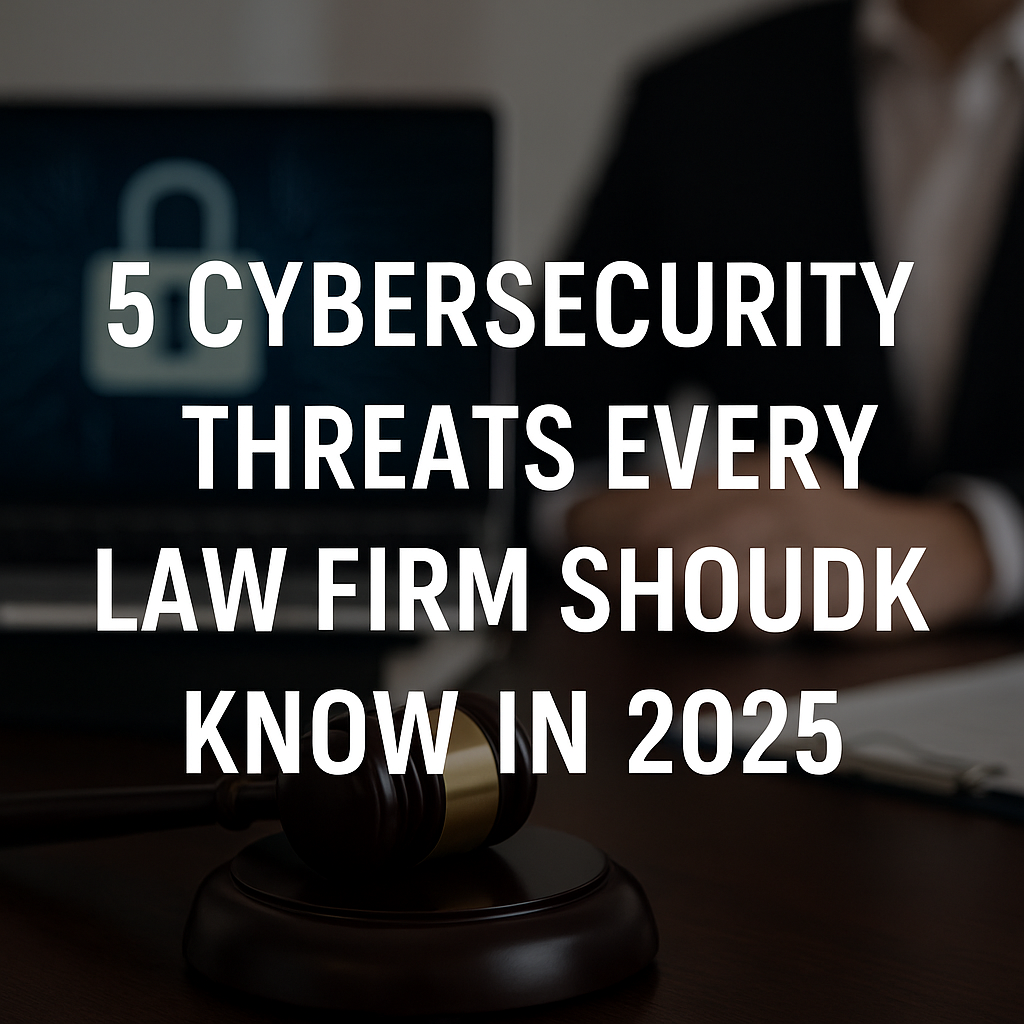
5 Cybersecurity Threats Every Law Firm Should Know in 2025
The legal industry is under siege. As we navigate through 2025, law firms face an unprecedented wave of sophisticated cyberattacks that threaten not only their operations but their very existence. According to a recent survey by Arctic Wolf and Above the Law, 39% of respondents reported that their firm has had a security breach that they were aware of in the last year, with 56% of those experiencing breaches losing confidential client data.
The stakes have never been higher. The average cost of a data breach for law firms in 2024 was $5.08 million, a more than 10% increase from the previous year. This alarming trend demands immediate attention from legal professionals who must understand that cybersecurity is no longer optional—it’s a fundamental requirement for practice survival.
1. Ransomware Attacks: The Digital Extortion Epidemic
The Current Threat Landscape
Ransomware has evolved from a nuisance to an existential threat for law firms. In 2024, there was an 11% increase in ransomware attacks compared to the previous year, totaling 5,414 published incidents. The legal sector has been particularly hard hit, with 2023 being a record-breaking year for ransomware attacks on law firms, with more than 45 attacks compromising over 1.5 million records.
Real-World Impact: High-Profile Cases
The threat is not theoretical. HWL Ebsworth — one of Australia’s largest law firms — suffered a ransomware attack by notorious ransomware-as-a-service (RaaS) group ALPHV/Blackcat in April 2023. The attackers accessed over 4TB of data, including employee resumes, IDs, financial reports, accounting data, client documentation, credit card information, and a complete network map.
Even more devastating was the case of Grubman Shire Meiselas & Sacks, which experienced a ransomware attack from the infamous REvil group in May 2020. The attackers initially asked for $21 million USD, then quickly doubled their payment demand to $42 million after threatening to release celebrity client information, including data involving Lady Gaga.
Perhaps most shocking is the case of Moses Afonso Ryan Ltd., which had its critical files locked down for three months due to a ransomware attack in 2016. The firm’s billing system and documents were frozen, resulting in nearly $700,000 USD lost in client billings, as well as the undisclosed ransom cost.
The Evolution of Double Extortion
Modern ransomware attacks employ “double extortion” tactics, where attackers not only encrypt files but also threaten to publicly release sensitive data unless ransom demands are met. The surge is largely thanks to the expansion of ransomware-as-a-service (RaaS) operations, which lowers the barrier to entry for cybercriminals by providing ready-made ransomware tools.
Prevention Strategies:
- Advanced Endpoint Detection: Deploy next-generation antivirus solutions with behavioral analysis capabilities
- Immutable Backups: Implement air-gapped backup systems that cannot be encrypted by ransomware
- Network Segmentation: Isolate critical systems to prevent lateral movement
- Zero-Trust Architecture: Verify every user and device before granting access
- Regular Vulnerability Assessments: Conduct quarterly penetration testing
Legal and Financial Implications
Beyond the immediate financial impact, ransomware attacks expose firms to malpractice claims and regulatory sanctions. Under ABA Model Rule 1.6(c), attorneys have a duty to make reasonable efforts to prevent unauthorized access to client information. Failure to implement adequate cybersecurity measures can result in ethical violations and costly litigation.
2. Phishing and Social Engineering: The Human Factor
The Persistent Threat
Phishing remains the most common attack vector against law firms. The prevalence of phishing attacks is particularly alarming, impacting 81% of the firms surveyed, marking a 14% increase from the year before. These attacks have become increasingly sophisticated, often targeting specific individuals within law firms with highly personalized content.
Business Email Compromise (BEC) Attacks
One of the most financially devastating forms of phishing is Business Email Compromise. These attacks involve cybercriminals impersonating senior partners or clients to authorize fraudulent wire transfers. The financial impact can be staggering, with individual incidents resulting in losses of hundreds of thousands of dollars.
Real-World Case Study
In 2024, a Florida-based law firm fell victim to a sophisticated phishing attack that resulted in $1.2 million in fraudulent wire transfers. The attackers used social engineering to gather intelligence about the firm’s clients and ongoing matters, then crafted convincing emails that appeared to come from legitimate clients requesting urgent wire transfers.
Emerging Tactics
Cybercriminals are increasingly using AI to enhance their phishing campaigns. According to CrowdStrike’s 2025 Global Threat Report, there was a 442% increase in voice phishing (vishing) attacks between the first and second halves of 2024, driven by AI-generated phishing and impersonation tactics.
Prevention Measures:
- Email Security Gateways: Implement advanced email filtering solutions
- Multi-Factor Authentication (MFA): According to Microsoft, MFA can block up to 99% of account-compromising attacks
- Regular Phishing Simulations: Conduct monthly phishing tests with immediate training
- Verification Protocols: Establish out-of-band verification for all financial transactions
- Security Awareness Training: Less than a third of training programs covered all “the big three” – remote work, password hygiene, and internet safety
“Cybersecurity is much more than a matter of IT.” — James Comey


3. Insider Threats: The Enemy Within
Understanding the Scope
Insider threats pose a unique challenge for law firms because they involve individuals with legitimate access to sensitive information. These threats can be intentional (malicious insiders) or unintentional (negligent employees). The privileged nature of attorney-client communications makes insider threats particularly damaging in the legal sector.
Types of Insider Threats
Malicious Insiders: Disgruntled employees, contractors, or business associates who intentionally misuse their access privileges. In 2022, an IT administrator at a UK law firm was caught selling client data to competitors, highlighting how trusted individuals can become the greatest security risk.
Negligent Insiders: Well-meaning employees who inadvertently compromise security through poor practices, such as sharing passwords, clicking on malicious links, or improperly handling confidential documents.
Compromised Insiders: Employees whose credentials have been stolen by external attackers, making it appear as though threats are coming from trusted sources.
Prevention Strategies:
- Zero-Trust Access Controls: Implement role-based access with the principle of least privilege
- Continuous Monitoring: Deploy User and Entity Behavior Analytics (UEBA) solutions
- Data Loss Prevention (DLP): Monitor and control data movement throughout the organization
- Regular Access Reviews: Conduct quarterly reviews of user permissions
- Background Checks: Implement comprehensive screening for all personnel with access to sensitive data
- Exit Procedures: Ensure immediate revocation of access when employees leave
Creating a Security-Conscious Culture
The most effective defense against insider threats is fostering a culture of security awareness. This includes encouraging employees to report suspicious behavior, providing clear guidelines on data handling, and ensuring that security policies are regularly updated and communicated.
4. Cloud and Remote Work Vulnerabilities: The New Attack Surface
The Remote Work Revolution
The pandemic fundamentally changed how law firms operate, with remote work becoming a permanent fixture. However, this shift has dramatically expanded the attack surface. An evolving digital landscape that sees firms relying more on web-based applications and the cloud has created new vulnerabilities that cybercriminals are eager to exploit.
Cloud Misconfigurations: A Critical Risk
One of the most significant threats comes from improperly configured cloud storage systems. In 2023, misconfigured AWS storage at a prominent NYC law firm exposed thousands of legal documents, including privileged attorney-client communications and sensitive case files. Such incidents can result in bar sanctions, malpractice claims, and irreparable reputational damage.
Common Cloud Security Failures:
- Default Security Settings: Many firms fail to change default configurations, leaving systems vulnerable
- Overprivileged Access: Granting excessive permissions to users and applications
- Unencrypted Data Storage: Storing sensitive information without proper encryption
- Inadequate Access Controls: Failing to implement proper authentication and authorization mechanisms
- Lack of Monitoring: Insufficient logging and monitoring of cloud environments
Remote Work Security Challenges
The shift to remote work has introduced numerous security challenges:
Unsecured Home Networks: Employees working from home networks with weak security configurations BYOD Risks: Personal devices accessing firm data without proper security controls Public Wi-Fi Usage: Attorneys accessing confidential information over unsecured networks Physical Security: Confidential documents and devices in unsecured home environments
Comprehensive Prevention Strategy:
- Cloud Security Assessments: Regular third-party audits of cloud configurations
- Endpoint Protection: Deploy enterprise-grade antivirus and endpoint detection on all devices
- VPN Solutions: Implement always-on VPN for all remote connections
- Mobile Device Management (MDM): Control and secure all devices accessing firm data
- Data Classification: Implement clear data classification and handling procedures
- Secure Communication Tools: Use encrypted communication platforms for sensitive discussions
5. AI-Powered Cyber Attacks: The Next Frontier
The Double-Edged Sword of AI
While AI offers tremendous opportunities for legal practice, it also empowers cybercriminals with unprecedented capabilities. According to Clio’s 2024 Legal Trends Report, the percentage of legal professionals using AI in their daily work increased from 19% in 2023 to 79% in 2024. However, there’s a double-edged sword with AI. Not only is AI bringing opportunities for law firms, but it’s also helping cybercriminals up their game by creating realistic content for elaborate attacks.
The Deepfake Epidemic
Deepfakes are a specific type of AI that has become especially prevalent and troublesome in the legal industry in recent years. The number of deepfake videos has surged by 550% between 2019 and 2023, reaching a total of 95,820 videos.
Shocking Real-World Impact
The most devastating example occurred in early 2024 when an employee of UK engineering firm Arup made a seemingly routine transfer of millions of company dollars, following a video call with senior management. Except, it turned out, the employee hadn’t been talking to Arup managers at all, but to deepfakes created by artificial intelligence. The employee had been tricked into sending $25 million to criminals.
During a video conference call attended by deepfakes impersonating the company’s Chief Financial Officer and other employees, a member of staff was duped into making 15 transactions totaling HK $200M (almost USD $26M) to five Hong Kong bank accounts.
The Scale of the Threat
The threat is rapidly expanding. Attacks relying on spoofed faces in online meetings surged by 300 percent in 2024, and iProov said it identified 31 new crews selling tools used for identity verification spoofing in 2024 alone.
Financial Impact of Deepfake Fraud
In 2024, businesses faced an average loss of nearly $500,000 due to deepfake-related fraud, with large enterprises experiencing losses up to $680,000. For law firms, the implications extend beyond financial losses to include ethical violations and malpractice claims.
AI-Enhanced Traditional Attacks
Beyond deepfakes, AI is enhancing traditional cyberattacks:
Personalized Phishing: AI analyzes social media and public information to create highly targeted phishing emails Automated Vulnerability Discovery: AI tools can identify and exploit security weaknesses faster than human attackers Password Attacks: AI-powered tools can crack passwords and defeat traditional security measures Social Engineering: AI can analyze communication patterns to create convincing impersonation attempts
Detection and Prevention Strategies:
- AI-Powered Security Tools: Fight fire with fire using AI-based threat detection
- Behavioral Analysis: Monitor for unusual patterns in user behavior and communication
- Verification Protocols: Establish code words or verification procedures for sensitive communications
- Deep learning Detection: Implement tools specifically designed to identify deepfake content
- Multi-Factor Authentication: Layer additional security beyond traditional passwords
- Employee Training: Regular training on identifying AI-generated content and social engineering tactics
Legal and Ethical Implications
The rise of AI attacks creates new challenges for legal professionals:
Evidence Authentication: How can courts verify the authenticity of digital evidence in the age of deepfakes? Confidentiality Concerns: AI attacks targeting attorney-client communications raise serious confidentiality issues Duty of Competence: Lawyers must understand AI threats to fulfill their duty of technological competence
The Path Forward
The cybersecurity landscape facing law firms in 2025 is more challenging than ever before. The threats are sophisticated, well-funded, and specifically targeting the legal sector. However, with proper preparation, investment, and commitment, law firms can build robust defenses against these threats.
Success requires a holistic approach that combines technology, training, and governance. Law firms must move beyond viewing cybersecurity as a compliance checkbox and recognize it as a fundamental business requirement. The firms that invest in comprehensive cybersecurity programs will not only protect themselves from devastating attacks but will also gain a competitive advantage in an increasingly security-conscious market.
The question is not whether your firm will be targeted—it’s whether you’ll be prepared when the attack comes. The time for action is now. Every day of delay increases your firm’s risk and exposure.
Take Action Today
Don’t wait for a cybersecurity incident to force your hand. Contact Finanxial IT at info@finanxialitcorp.com or visit finanxialitcorp.com for a comprehensive security assessment. Our team of cybersecurity experts specializes in protecting law firms from the evolving threat landscape, ensuring your practice remains secure, compliant, and competitive.
Your clients trust you with their most sensitive information. Make sure that trust is never broken by a preventable cybersecurity incident. The future of your firm depends on the cybersecurity decisions you make today.
Recent Blogs
- Beyond Passwords: The Future of Cybersecurity for Law Firms
- Digital Transformation with AI: Optimizing Your Law Firm’s IT Infrastructure
- 5 Cybersecurity Threats Every Law Firm Should Know in 2025
- Uncovering the Truth with Forensics: Finanxial IT’s Expertise in Digital Investigations
- Navigating the Generational Shift: Leading a Multi-Generational Workforce in the Age of AI Innovation


